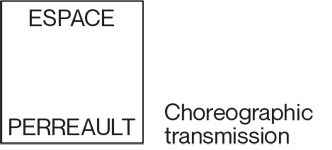A project imagined by Pierre-Marc Ouellette:
My entry into the world of Montreal contemporary dance in 2002 coincided with the passing of Jean-Pierre Perreault. A mythical figure who profoundly influenced the careers and lives of my teachers, I primarily know the man through what has been told to me about him. Despite this, I feel like I carry traces of his work within my body (without really knowing what these traces represent). While Perreault left his mark on the lives and professional paths of many renowned performers, he also influenced an entire generation of choreographers. Today, as my creative life revolves around choreography, I feel the shadow of Perreault hovering over me. It is with the intention of questioning this shadow that I propose to undertake the Ghost Archive project.
The purpose of this research and creative project is to invoke the ghost of Perreault through the creation of an imagined archive. To do this, I would like to start by immersing myself (reading, viewing photos and videos) into the archive of Espace Perreault Transmissions chorégraphiques, formerly the Fondation Jean-Pierre Perreault, to saturate my mind with inspiration. Then, I would like to conduct interviews with three important figures in my artistic journey to explore Perreault’s contributions to their respective creative worlds. Next, I intend to explore the Jean-Pierre Perreault building in an exploratory manner, a place that would be inhabited by the ghost of Jean-Pierre. Finally, I aim to go into the studio to work with performers and choreographers from a younger generation with the idea of transmitting fragments of Perreault’s legacy, as well as the information gathered during this research: creative principles, gestural inspirations, movement textures, sensations, and more.
Every stage of the research, which will take place in the spring and summer of 2024, will be captured on video. The culmination of the project will take the form of a short documentary work in the style of a video diary. It’s worth noting that the project is still in the conceptualization stage; as a result, the working team has not yet been formed, and I have not yet contacted the participating artists. In preliminary discussions, Nicolas Bernier (musical composer), Manon De Pauw (photographer/videographer), a camerawoman, and three or four emerging performers/choreographers.
Amidst the fog, bodies appeared.
During my master’s degree journey, which took place during the pandemic, I had to rethink my final project so that my jury could evaluate the outcome of my research without needing to be present. As a result, I developed a taste for documentation and video. At the same time, I created three video-dance capsules designed to bring dance to life on social media during the lockdown. Produced with limited resources, these capsules were well-received and garnered generous feedback. I discovered the mediating power of social networks and the desire to invest and refine my approach in video.
As for the idea of creating an imagined archive, it is linked to a research and creation method I have been experimenting with recently. This method allows for the emergence of inspiration in a spirit of discovery and availability. The parameters of creation are open, sometimes blurry, and are defined and refined during the process. In this process, the accumulation of information come together to form a single unorganized unit, a creative fog in which project participants are willing to dive, building unusual connections or animating their bodies intuitively.
From Perreault to Boissinot, Boivin, Desnoyers, to my own body, a creative lineage emerges. At the midpoint of my life, I become a vector of transmission in this chain as my teaching activities become increasingly important. Also, as choreography confirms itself as the new path in my practitioner’s career, it seems essential to open up a space that allows me to explore my artistic lineage and, by extension, offer a younger generation than mine an opportunity to engage with Perreault’s creative legacy.
Finally, in this project, the body is seen as the host of ghostly forces : the real or imagined traces of Perreault’s work. In the creative fog, each person involved in the research will be called upon to bring forth these traces through speech or movement. Ironically, the bodies of Ghost Archive are considered vehicles of “embodied knowledge” and an archive that is very much alive.
(1) Lucie Boissinot, Marc Boivin, and Danièle Desnoyers are prominent dancers, choreographers, and performers associated with the company of Jean-Pierre Perreault. They are also the individuals who have had the greatest impact on my journey. Throughout this journey, they have expressed the influence of Perreault on their lives and careers. I would like to conduct interviews with them, depending on their availability and willingness.
(2) The ideas presented in this paragraph were inspired by the text “The Holding Space: Body of (as) Knowledge” authored by Sally Doughty, Lisa Kendall, and Rachel Krische. You can find this text online at the following link: https://link.springer.com/chapter/10.1007/978-3-030-44085-5_6
